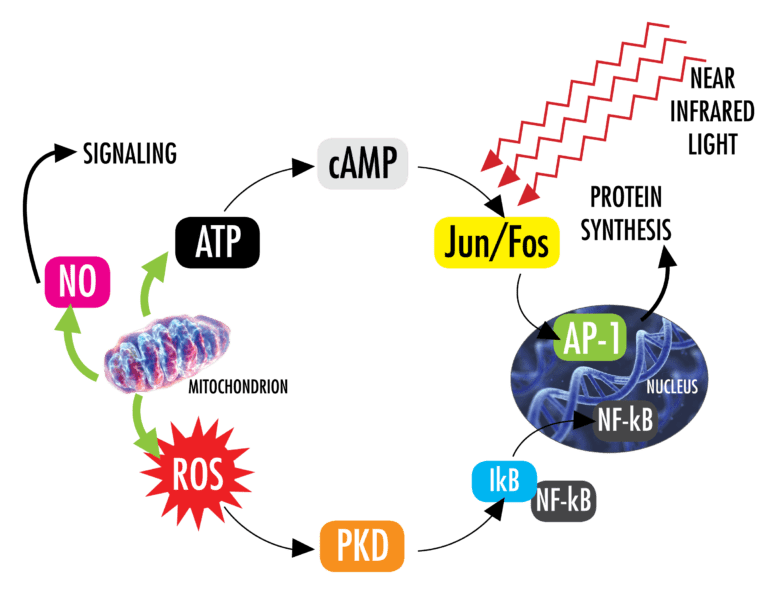The Ultimate Guide To Photobiomodulation
Wiki Article
Photobiomodulation Fundamentals Explained
Table of ContentsThe Facts About Photobiomodulation UncoveredPhotobiomodulation Things To Know Before You BuyPhotobiomodulation Things To Know Before You BuyThe Basic Principles Of Photobiomodulation
Laser treatment is a medical therapy that utilizes focused light to boost a procedure called. During PBM, photons go into the tissue and engage with the cytochrome c complex within mitochondria. This communication activates a biological waterfall of occasions that leads to an increase in mobile metabolic process, which can as well as accelerate the healing procedure.There is consensus that the application of a restorative dose of light to damaged or inefficient tissue brings about a cellular reaction mediated by mitochondrial devices. Photobiomodulation. Researches have actually shown that these changes can influence pain and inflammation, as well as, tissue repair work
Adjustments in ATP, reactive oxygen varieties and nitric oxide adhere to light absorption by Cc, O. These impacts are redox state and dosage reliant.

Photobiomodulation Fundamentals Explained
PBM gadgets have actually been cleared for advertising by FDA via the Premarket Notification/510( k) process as adjunctive gadgets for the short-term relief of pain. These clearances were based upon the discussion of professional information to sustain such insurance claims (Photobiomodulation). In this therapy, a light resource is positioned near or touching the skin, enabling the light energy (photons) to penetrate tissue where it communicates with chromophores located in cells resulting in photophysical and photochemical adjustments that result in modifications at the molecular, mobile and cells degrees of the bodySurprisingly, recent research study shows that light can enhance performance in regular cells and cells. The prospective applications of PBMT are many and are being discovered experimentally at the fundamental science, pre-clinical and professional degree. The current medical usages are for the relief of pain and inflammation and the therapy of sporting activities injuries.

The treatment specifications and number of sessions required for PBMT are dependent upon place and reason. PBMT typically needs more than one treatment for optimum discomfort alleviation.
The Main Principles Of Photobiomodulation
Therapy criteria for PBMT were originally developed making use of cells in vitro and in small pet models. These therapy specifications usually had a low irradiance and fluence and see page worked well for cutaneous applications. When medical professionals began to use PBMT to deal with structures that were situated much deeper in the body, they utilized these parameters with unfavorable results.
We currently comprehend that these unfavorable researches resulted from inaccurate tool and treatment specifications for transcutaneous therapy of much deeper structures. Current developments in laser therapy devices and more research right into the suitable does have considerably boosted the outcomes of PBMT. For dealing with deep cells, the wavelength of light utilized figures out the depth of penetration into a cells.
It is important that a medical professional uses the appropriate wavelength of light and parameters to deal with a this problem. One wavelength and one collection of therapy specifications will not be effective for all problems. Adverse side effects have actually not been reported from the usage of PBMT (Photobiomodulation). Upgraded June 27, 2016Juanita j
Light treatment is a non-invasive therapy that works by boosting the ability of the cell to create power (ATP) to heal the area being dealt with. As an outcome, it can reduce swelling, swelling, and pain in the location. Research around is broadening, with more extensive study papers connected below for those who would love to discover more.
The 5-Minute Rule for Photobiomodulation
In the first experiment, Dr. Endre Mester, utilized cut rats and observing how the laser influenced their capacity to expand hair contrasted to the group that was not receiving LLLT. He located that the group of computer mice receiving LLLT were able to expand their hair back quicker than the group of mice that didn't get LLLT (Hoon C, et al; 2012).This treatment is called by doing this to differentiate the difference between the lasers some professions make use of to cut (eg. in surgical treatments, or oral treatments). Low-level light therapy is painless, non-invasive treatment. It is utilized to lower swelling, swelling, and persistent joint problems, decrease pain and accelerate injury recovery of nerves and cells (Hoon C, et al; 2012).
LLLT has a biphasic response, suggesting that reduced dosages are usually attended be more useful than greater doses. That being said, doses higher or reduced than the optimum dose doesn't affect (Hoon C, et al; 2012). Because of this, it can be challenging to have studies on LLLT with numerous parameters.
Some companies combined the 2 (LED and laser) to offer a more well-rounded therapy since lasers can pass through deeper than LED and infrared light (Norman Doidge, The Brain's Way of Recovery, 2015). During therapy, the location that is being treated is subjected to LED light from a Biography, Flex next Laser, which goes to 660 nm wavelength, adhered to by infrared light at 830-840 nm wavelength.
Report this wiki page